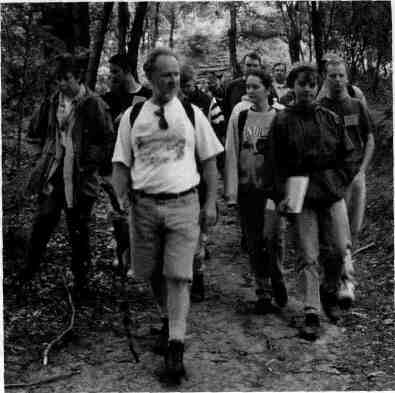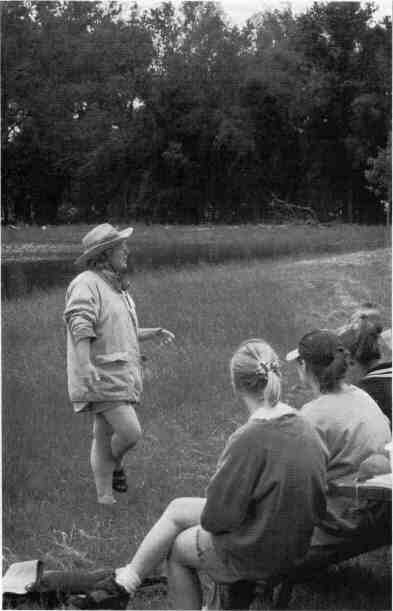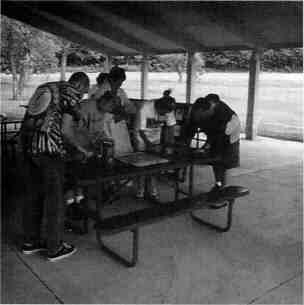
OUR NATURAL RESOURCES
BY JASON L JENKINS

|
Toby Miller, site interpreter for Starved Rock State Park, leads a group of seasonal interpreters on a hike through Pere Marquette State Park. |
Just for a moment, think back to the last time you went hiking in a state park. As you walked through the forest, the air filled with the sweet harmonies of songbirds. Later, as the scenery changed from forest to prairie, you discovered the ground covered with wildflowers.
Could you identify each bird by its song? And could you identify each spectacular splash of purple, yellow and blue that painted the prairie? Probably not, but that's all right. Because if your hike was guided by the site's interpreter, most of your questions would have been answered before you left for home.
As the importance of environmental education and recreational opportunities continues to grow, so too does DNR's Statewide Interpretive Program. Its goal is to provide site visitors, youth groups, constituency groups and the general public with a better understanding of the environment through interpretation of the state's natural, historical and cultural resources.
For many, the use of the term "interpreter" may be confusing. Typically, it refers to a translator, someone who enables those of different languages to communicate. However, interpretation is not limited to simply bridging language barriers. It can also bridge barriers people have with understanding and appreciating the state's natural resources.
"Our interpreters are more commonly known as naturalists or park naturalists," says Interpretive Program Manager Mitch Ingold.
DNR employs 24 full-time interpreters at sites around the state. Though each location is unique, the interpreters' responsibilities are fairly similar. They lead guided hikes and tours, offer school group programs, coordinate special events and provide outdoor education and recreational programs. In 1998, total attendance at interpretive programs exceeded 107,500 people.
July/August 1999 / 45
OUR NATURAL RESOURCES

|
Stacy Miller, site interpreter for Volo Bog State Natural Area, explains some of monitoring activities conducted through RiverWatch to a group of seasonal interpreters. RiverWatch is a partnership of Illinois citizens to monitor, restore and protect the state's rivers and streams. |
Gearing Up for the Summer
As attendance at sites increases during the busy summer months, DNR offers more interpretive opportunities for visitors through its Seasonal Interpreter Program—a program that reached about 15,000 people in 1998. This summer, 35 interns will serve as seasonal interpreters, most of whom will be placed at sites that do not have full-time interpreters.
"The seasonal program supplements existing interpretive programs and services," says Ingold. "We prefer that our seasonals are at least juniors in college, studying in a natural resource-related degree program."
Ingold adds that most seasonal interpreters will work for a period of three months, though some will work for up to six months.
The seasonal program is funded by the sale of environmental license plates, a source that has allowed seasonal interpreters to receive training from full-time interpreters before dealing with the public for the first time.
This spring marked the sixth year of the seasonal interpreter training, which was held at Pere Marquette State Park near Grafton in late May.
"When we started the training, it was a one-day ordeal," recalls Ingold. "It's really built up over the years."
Ingold also adds that DNR has partnered with the Army Corps of Engineers to train its seasonal interpreters. "It gives our people the chance to work together," he says.
During the training, seasonal interpreters watch full-time interpreters in action. This "learning by example" takes a hands-on approach where seeing, touching, smelling and hearing are emphasized. This not only allows seasonals to get a feel for interpretation, but also provides them with background knowledge and techniques that they can take back to their respective sites.
"We focus on activities they will most likely do over the summer," says Ingold. "By talking with site superintendents, we try to get a feel for what needs to be accomplished."
For the most part, the primary responsibility for seasonal interpreters will be to lead guided hikes. Seasonals also will work with school and youth groups, staff visitor centers, build interpretive displays and offer educational and recreational programs. But beyond their actual training, the four days spent together allow for other advantages.
"It's a great opportunity for the seasonals to get to know each other and the full-time interpreters," Ingold says. "It makes them more comfortable and helps to build more of a relationship."
46 / Illinois Parks and Recreation
OUR NATURAL RESOURCES

Enthusiastic Involvement
One of this summer's seasonal interpreters is Josh Nagy. A senior at Eastern Illinois University majoring in zoology, Nagy says that he became involved in the program by chance.
"I was just looking for a job for the summer and went out to Fox Ridge State Park for an application," he says. "They told me about the internship as an interpreter, and I decided to apply for it."
Nagy will be the seasonal interpreter at Fox Ridge for four months. He says that the training he received has given him a lot of ideas to build upon.
"I'm a lot more relaxed about what I'm going to do," he says. "I really like it."
Others in the program share his enthusiasm.
"This is exactly what I want to do," says Kelly French, a senior majoring in environmental education and interpretation at the University of Wisconsin at Stevens Point. This is French's second summer as the seasonal interpreter at Rock Cut State Park.
Originally from Rockford, French was looking for a summer job close to home when she stumbled across the Seasonal Interpretive Program. She says that the experience has definitely been worthwhile.
"I had a lot of fun last summer as an interpreter," she remarks. "So I asked myself, 'Why go anywhere else?'"
French adds that the training she received was very useful because it gave her a lot of ideas to work from in developing her seasonal programs at Rock Cut, which included guided hikes, slide shows and environmental education activities with Scout groups and school children.
"I decided to come back because I got a lot out of it," she says. "Plus, the classes I took over the last year will help to improve my interpretive skills."
French will serve as Rock Cut's interpreter for three months before returning to school in the fall.
As the public places more emphasis on environmental education, DNRs Interpretive Program will continue to expand, offering a variety of programs and opportunities around the state.
"Right now, we have more interpreters than ever before," concludes Ingold. "The field of interpretation is here to stay."
JASON L. JENKINS
About the photo on this page: Interactive activities such as puzzles, trivia questions and games are tools
interpreters can use to involve visitors in their programs.
is an intern serving as a staff writer for OutdoorIllinois. a publication of the Illinois Department of Natural
Resources This article is reprinted with permission from the July 1999 issue of Outdoorlllinois. jenkins also
shot all the photographs for this story.
July/August 1999 / 47
OUR NATURAL RESOURCES NEWS BRIEFS

Free expert instruction and free loaner equipment are available again this year through the Department of Natural Resources' Urban Fishing Program and Access to Fishing equipment loan initiative.
Although the fishing clinics are geared toward children ages 16 and younger, anyone interested in learning to fish may participate in die free clinics available at 25 sites throughout the state. Arrangements can also be made to provide fishing clinics for seniors or groups with special needs.
DNR employs seasonal instructors, including school teachers, to present me fishing clinics. Rods and reels, bait and tackle are provided at no charge to clinic participants. The catch-and-release clinics are offered twice each weekday during the summer months.
"Those who sign up for the free clinics receive instruction on aquatic ecology, how to identify and handle fish, on fishing safety and ethics, and on the basics such as how to tie a fishing knot, bait a hook, cast a line and catch fish," said Mike Conlin, chief of DNR's Division of Fisheries.
For novice anglers unable to afford fishing tackle, or those interested in trying the sport before buying their own equipment, more than 70 public libraries, park districts and other Access to Fishing loaner sites offer an opportunity to borrow a rod and reel. The equipment loan sites also provide tackle packs with accessories that may include bobbers, jigs, weights, hooks and a stringer.
Most tackle packs are donated through local service dubs and civic organizations. DNR purchases Zebco rods and reels for the program with a discount through the American Sport Fishing Association, a national trade organization.
Public libraries, parks and recreation districts interested in participating as an equipment loaner site can contact the Urban Fishing Program at 217.782.6424 for more information.
This year Urban Fishing Program clinics will be held:
• June 7-July 2 at City Park Lake, Mount Vernon.
• June 7-July 30 at Gordon Moore Park, Alton; SIU Campus Lake Carbondale; and Jones Park, East St. Louis.
• June 14-Aug. 6 at Riverside Park, Moline; Glen Oak Park Lagoon, Peoria; Levings Lake, Rockford Dreamland Pond in Fairview Park, Decatur; Washington Park Pond, Springfield; and Crystal Lake Park, Urbana.
• June 21-Aug. 20 at Chicago Park District lagoons at Columbus/Douglas, Gompers, Humboldt, Jackson, Marquette, McKinley, Sherman and Washington parks, Chicago; Cook County Forest Preserves at Flatfoot Lake, Dolton; Cermack Quarry, Lyons; Schiller Pond, Schiller Park; Lake Owens, Hazel Crest; Community Park Pond, Mundelein; and Elliott Lake, Wheaton.
• July 5-30 at Centralia Foundation Lake, Centralia.
|
Anniversary Stamp Set Is Now Available Individuals who requested low or specific stamp numbers of a special commemorative display celebrating the 25th anniversary of the Illinois Migratory Waterfowl Stamp have been notified of the June 1 lottery results. Now, the limited-edition stamp display is being offered on a first-come, first-served basis. The display features a matching numbered set of the 1999 Illinois Migratory Waterfowl Stamp, which is adapted from the painting "Black Labrador—Canada Geese" by wildlife artist Jim Killen. The painting is the first in the four-set "Sporting Dog Series" of Illinois waterfowl stamps. The framed display contains the full-color Anniversary Edition, the full-silver-foil Silver Edition and the full- color Governor's Edition with silver-foil border. Each set is accompanied by a certificate of authenticity signed by Gov. George H. Ryan and a letter from Department of Natural Resources Director Brent Manning detailing the history of the Illinois Migratory Waterfowl Stamp program. With a production run restricted to 500 sets, only a limited number remain. To order the special limited-edition display or to request an application or more information, call 1.800.720.3249, 217.782.7454 of TTY 217.782.9175 or access DNR's Website at http://dnr.state.il.us. |
July/August 1999 / 49
OUR NATURAL RESOURCES NEWS BRIEFS
Gov. George H. Ryan has signed legislation to extend the definition of
reckless homicide to include deaths caused by the intentionally reckless
operation of watercraft, snowmobiles or all-terrain vehicles.
"We must ask everyone to act safely and responsibly," Ryan said. "Unfortunately, there are several accidents each year in Illinois because of the
reckless operation of boats and other recreational vehicles that result in
innocent passengers or bystanders being killed. Anyone who causes these
accidents must be held accountable for their actions."
Current law provides that the reckless operation of a motor vehicle that
results in death is classified as reckless homicide. The newly signed bill
amends the criminal code to make the reckless operation of a snowmobile,
all-terrain vehicle or watercraft that results in death equal to the reckless
operation of a motor vehicle.
"Boaters should be held accountable to the same laws as drivers where
drinking or drugs are concerned," said Sen. Adeline Geo-Karis (R-Zion),
one of the bill's sponsors. "There have been too many accidents on the
Chain O'Lakes where innocent people have been injured or killed by
impaired boaters. "Why should baiting under the influence be any different than driving under the influence? The risks are just as great. A life is
something we cannot recapture."
In 1998, there were 176 reported recreational boating accidents in
Illinois that killed 19 people. More than 90 percent of the boat crashes on
the state's rivers and lakes last year occurred between May and September,
and 83 percent of the crashes last year occurred during weekends—on
clear days with slightly choppy waters. Almost 60 percent of the crashes
involved boats hitting one another or a fixed object.
The legislation, strongly supported by Mothers Against Drunk Driving, takes effect January 1, 2000.
Boat operators and passengers are being reminded to wear life jackets as they head to the water for the boating season this year.
"The vast majority of deaths and injuries in boating accidents
involve boaters who are not wearing life jackets," Department of
Natural Resources Director Brent Manning says. "We cannot emphasize enough the importance of wearing an approved life jacket while enjoying time on the water."
Manning said 19 people died as a result of boating accidents on Illinois waterways in 1998. That
compares with 14 fatalities during 1997, 27 in 1996, 16 in 1995 and 17 in 1994.
There were a total of 176 boating accidents in Illinois last year, compared with 146 accidents in
1997, 155 in 1996, 178 in 1995 and 157 in 1994.
"Of the 19 people who lost their lives in bearing accidents in Illinois in 1998, 12 of them were not
wearing life jackets," said Tom Wakolbinger, chief of DNR's Office of Law Enforcement. "Life jackets are life savers, and the models available today are lightweight and easy to wear."
Illinois law requires life jackets, also known as personal flotation devices, or PFDs, be available for each person aboard a watercraft. State law also requires anyone operating a personal watercraft to
wear a life jacket.
Illinois law also requires youngsters under the age of 13 to wear a life jacket while aboard any watercraft under 26 feet in length at all times the boat is underway, unless they are below deck in an
enclosed cabin.
The Department offers free boating safety courses, which include a review of boating laws and instruction on operating watercraft with safety in mind. These free courses are
open to anyone age 19 and older and are required for young people ages 12 to 18 who want to operate a boat or personal watercraft without adult supervision.
Boating safety course information and schedules are available by contact DNR's Safety Education Office at 1.800.832.2599, TTY 217.782.9175.
Wakolbinger also reminded boaters that conservation police and other law enforcement agencies
strictly enforce laws against boaters operating under the influence (OUI).
"Watercraft operators can be cited for OUI if testing indicates their blood alcohol concentration exceeds the level of 0.08," Wakolbinger said. "Boaters should remember that they can have
fun on the water without being under the influence of alcohol or drugs."
50 / Illinois Parks and RecreationBoats, ATVs, Snowmobiles Are Subject of New Legislation
Life Jackets Are Life Savers; Wear One While Boating
